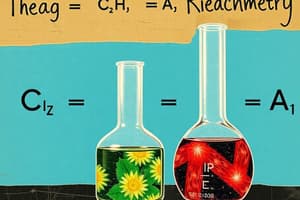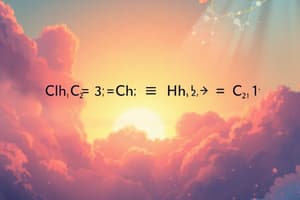Podcast
Questions and Answers
Which statement best describes the relationship between moles, molecules, and grams in chemical calculations?
Which statement best describes the relationship between moles, molecules, and grams in chemical calculations?
- Moles directly measure mass in grams, while molecules are used for volume calculations.
- Molecules are converted to moles by dividing by molar mass, which can then be converted to grams.
- Grams are converted to moles using Avogadro's number, and molecules are extraneous to mass calculations.
- Moles provide a direct count of molecules and relate to grams through molar mass, enabling mass-to-molecule conversions. (correct)
A compound is found to contain 40% carbon, 6.7% hydrogen, and 53.3% oxygen by mass. What is its empirical formula?
A compound is found to contain 40% carbon, 6.7% hydrogen, and 53.3% oxygen by mass. What is its empirical formula?
- C₂H₂O
- C₂H₄O₂
- CHO
- CH₂O (correct)
In the combustion analysis of a hydrocarbon, what information is directly obtained that helps determine the empirical formula?
In the combustion analysis of a hydrocarbon, what information is directly obtained that helps determine the empirical formula?
- The rate of the combustion reaction.
- The volume of oxygen consumed.
- The mass of water and carbon dioxide produced. (correct)
- The molar mass of the hydrocarbon.
Which of the following is NOT one of the five basic types of chemical reactions?
Which of the following is NOT one of the five basic types of chemical reactions?
Which type of chemical equation specifically shows only the soluble, strong electrolytes reacting in aqueous solution?
Which type of chemical equation specifically shows only the soluble, strong electrolytes reacting in aqueous solution?
In a chemical reaction, how does the limiting reactant affect the amount of product formed?
In a chemical reaction, how does the limiting reactant affect the amount of product formed?
If 25.0 g of $Fe_2O_3$ reacts with 25.0 g of $CO$ according to the equation $Fe_2O_3(s) + 3CO(g) \rightarrow 2Fe(s) + 3CO_2(g)$, what is the limiting reactant?
If 25.0 g of $Fe_2O_3$ reacts with 25.0 g of $CO$ according to the equation $Fe_2O_3(s) + 3CO(g) \rightarrow 2Fe(s) + 3CO_2(g)$, what is the limiting reactant?
How is molarity defined, and what does it express?
How is molarity defined, and what does it express?
According to the Kinetic Molecular Theory (KMT), which statement is true regarding gas particles?
According to the Kinetic Molecular Theory (KMT), which statement is true regarding gas particles?
A closed container holds a mixture of nitrogen and oxygen gases. If the total pressure inside the container is 3 atm and the partial pressure of nitrogen is 1 atm, what is the partial pressure of oxygen?
A closed container holds a mixture of nitrogen and oxygen gases. If the total pressure inside the container is 3 atm and the partial pressure of nitrogen is 1 atm, what is the partial pressure of oxygen?
Flashcards
Periodic Table
Periodic Table
Arrangement of elements by atomic number, showcasing periodic properties.
Mole
Mole
The amount of a substance containing the same number of entities as there are atoms in 12 grams of carbon-12.
Combustion Analysis
Combustion Analysis
Combustion analysis determines the empirical formula of a compound by burning a known mass of the substance and measuring the masses of the products (CO2 and H2O).
Redox Reaction
Redox Reaction
Signup and view all the flashcards
Gases
Gases
Signup and view all the flashcards
Ideal Gas Law
Ideal Gas Law
Signup and view all the flashcards
Partial Pressure
Partial Pressure
Signup and view all the flashcards
Kinetic Molecular Theory (KMT)
Kinetic Molecular Theory (KMT)
Signup and view all the flashcards
Limiting Reactant
Limiting Reactant
Signup and view all the flashcards
Solution and Molarity
Solution and Molarity
Signup and view all the flashcards
Study Notes
- The periodic table has 9 regions that organize elements based on their properties.
- Naming conventions are used to identify elements and compounds.
- Moles, molecules, atoms, and grams are units used to quantify matter, with conversions possible between them.
- Mass percent expresses the concentration of a substance in a mixture or compound.
- Percentage can be used as a conversion factor in calculations.
- Percentage composition indicates the proportion of each element in a compound.
- Combustion analysis determines the elemental composition of a substance through combustion reactions.
Chemical Reactions
- Chemical reactions involve the rearrangement of atoms and molecules.
- There are 5 main types of chemical reactions.
- Chemical equations represent reactions, must be balanced.
- States of matter (solid, liquid, gas, aqueous) are indicated in chemical equations.
- Three types of equations for each reaction type.
Stoichiometry
- Stoichiometry deals with the quantitative relationships between reactants and products in chemical reactions.
- Limiting reactant determines the maximum amount of product that can be formed.
- Solutions are homogeneous mixtures, and molarity expresses the concentration of a solute in a solution.
- Redox reactions involve the transfer of electrons between species.
Gases
- Gases are a state of matter characterized by widely spaced particles and no fixed volume or shape.
- The ideal gas law, PV=nRT, relates pressure, volume, number of moles, and temperature of a gas.
- Variations of the ideal gas law allow for the calculation of different gas properties.
- Partial pressure is the pressure exerted by an individual gas in a mixture of gases.
- Kinetic Molecular Theory (KMT) describes the behavior of gases at the molecular level.
Studying That Suits You
Use AI to generate personalized quizzes and flashcards to suit your learning preferences.




